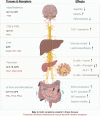Variation in responses to incretin therapy: Modifiable and non-modifiable factors
- PMID: 37091864
- PMCID: PMC10119428
- DOI: 10.3389/fmolb.2023.1170181
Variation in responses to incretin therapy: Modifiable and non-modifiable factors
Abstract
Type 2 diabetes (T2D) and obesity have reached epidemic proportions. Incretin therapy is the second line of treatment for T2D, improving both blood glucose regulation and weight loss. Glucagon-like peptide-1 (GLP-1) and glucose-stimulated insulinotropic polypeptide (GIP) are the incretin hormones that provide the foundations for these drugs. While these therapies have been highly effective for some, the results are variable. Incretin therapies target the class B G protein-coupled receptors GLP-1R and GIPR, expressed mainly in the pancreas and the hypothalamus, while some therapeutical approaches include additional targeting of the related glucagon receptor (GCGR) in the liver. The proper functioning of these receptors is crucial for incretin therapy success and here we review several mechanisms at the cellular and molecular level that influence an individual's response to incretin therapy.
Keywords: GIP (glucose-dependent insulinotropic polypeptide); GLP-1 (glucagon-like peptide-1); T2D (type 2 diabetes); incretin receptors; incretin—based therapy; obesity.
Copyright © 2023 Austin and Tomas.
Conflict of interest statement
The authors declare that the research was conducted in the absence of any commercial or financial relationships that could be construed as a potential conflict of interest.
Figures
Similar articles
-
Human epicardial adipose tissue expresses glucose-dependent insulinotropic polypeptide, glucagon, and glucagon-like peptide-1 receptors as potential targets of pleiotropic therapies.Eur J Prev Cardiol. 2023 Jun 1;30(8):680-693. doi: 10.1093/eurjpc/zwad050. Eur J Prev Cardiol. 2023. PMID: 36799940
-
Single incretin receptor knockout mice do not compensate by increasing glucose-stimulated secretion of the remaining incretin hormone.Am J Physiol Endocrinol Metab. 2025 Mar 1;328(3):E435-E446. doi: 10.1152/ajpendo.00437.2024. Epub 2025 Feb 11. Am J Physiol Endocrinol Metab. 2025. PMID: 39933706
-
Incretin hormones and type 2 diabetes.Diabetologia. 2023 Oct;66(10):1780-1795. doi: 10.1007/s00125-023-05956-x. Epub 2023 Jul 11. Diabetologia. 2023. PMID: 37430117 Free PMC article. Review.
-
Glucose-dependent insulinotropic polypeptide and glucagon-like peptide-1: Incretin actions beyond the pancreas.J Diabetes Investig. 2013 Mar 18;4(2):108-30. doi: 10.1111/jdi.12065. J Diabetes Investig. 2013. PMID: 24843641 Free PMC article. Review.
-
Incretin-mediated control of cardiac energy metabolism.J Endocrinol. 2024 Aug 8;263(1):e240011. doi: 10.1530/JOE-24-0011. Print 2024 Oct 1. J Endocrinol. 2024. PMID: 39013412 Review.
Cited by
-
Unveiling the Therapeutic Potential of the Second-Generation Incretin Analogs Semaglutide and Tirzepatide in Type 1 Diabetes and Latent Autoimmune Diabetes in Adults.J Clin Med. 2025 Feb 15;14(4):1303. doi: 10.3390/jcm14041303. J Clin Med. 2025. PMID: 40004833 Free PMC article. Review.
-
Tirzepatide 10 and 15 mg versus semaglutide 2.4 mg in people with obesity or overweight with type 2 diabetes: An indirect treatment comparison.Diabetes Obes Metab. 2025 Jul;27(7):3757-3765. doi: 10.1111/dom.16401. Epub 2025 May 5. Diabetes Obes Metab. 2025. PMID: 40321113 Free PMC article. Clinical Trial.
-
Reduced Efficacy of Glucagon-Like Peptide-1 Receptor Agonists Therapy in People With Type 1 Diabetes and Genetic Forms of Obesity.J Diabetes Sci Technol. 2025 Mar;19(2):297-303. doi: 10.1177/19322968241245680. Epub 2024 Apr 17. J Diabetes Sci Technol. 2025. PMID: 38629877 Free PMC article.
References
-
- Al-Zaid B., Chacko S., Ezeamuzie C. I., Bünemann M., Krasel C., Karimian T., et al. (2022). Differential effects of glucose-dependent insulinotropic polypeptide receptor/glucagon-like peptide-1 receptor heteromerization on cell signaling when expressed in HEK-293 cells. Pharmacol. Res. Perspect. 10, e01013. 10.1002/prp2.1013 - DOI - PMC - PubMed
-
- Ambery P., Parker V. E., Stumvoll M., Posch M. G., Heise T., Plum-Moerschel L., et al. (2018). MEDI0382, a GLP-1 and glucagon receptor dual agonist, in obese or overweight patients with type 2 diabetes: A randomised, controlled, double-blind, ascending dose and phase 2a study. Lancet 391, 2607–2618. 10.1016/S0140-6736(18)30726-8 - DOI - PubMed
Publication types
Grants and funding
LinkOut - more resources
Full Text Sources


